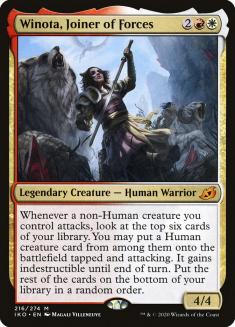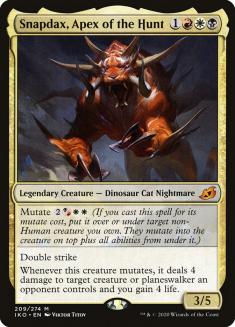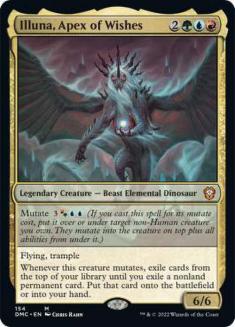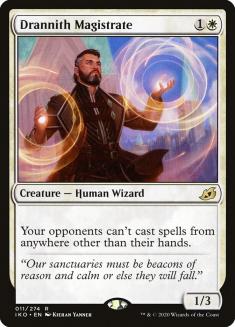What a ride Ikoria gave us, eh? Companion came with a bang, mutate came with a whimper, cycling still rules, and Godzilla Series Monster Cards seem sooooooo last weekend (I blame COVID-19).
We’ve never seen a set like Ikoria before and it’s probably best we never will again — which is all the more reason to bring together the same five members of the SCG staff from our Ikoria: Lair of Behemoths First Impressions article to answer a few exit interview questions before Core Set 2021 preview season begins on Thursday.
1. What is your Tweet-length review of Ikoria: Lair of Behemoths?
Nick Miller: It’s easy to pile on R&D for the many problems in Ikoria, but at least they were made with interesting and creative goals. Balancing companions was impossible so we’ll see what happens from here. With the exception of Zenith Flare going face, the Draft format is incredible.
Carmen Handy: A set so complex that the best cards don’t even say what they do on them.
Ryan Overturf: I’ll remember Ikoria as a set with high highs and low lows. Companion was a mess. I don’t like how cycling was pushed in Limited, though it’s been fun in Constructed. I really hate Triomes. I do enjoy the world and some card designs. Shark Typhoon rules. Also Godzilla.
Dom Harvey: Spacegodzilla needs to issue a statement disavowing Ikoria immediately to protect its own reputation.
Ari Lax: There are 200 cards that play like they are from 2007 that do a bunch of weird nonsense that amounts to lots of false choices and medium outcomes. Then there are ten cards that play like they are from 2019 and ruin every format forever. They all have cool art descriptions.
2. What is your most-liked card in Ikoria: Lair of Behemoths?
Dominic Harvey: Winota, Joiner of Forces. In simpler times, this card would be even more egregious. Aetherworks Marvel ruined several iterations of Standard and made you build around a mechanic that took additional bans to bring it down to earth — Winota asks so much less and often gives you even more.
However, with every format in Magic and the outside world all scrambled in chaos, Winota feels weirdly… comforting? I’ve always lived the thrill of shoving my proverbial chips in the middle of the safe sandbox Magic provides. Why would I want to hit two creatures with every Collected Company? The fact that Spoils of the Vault can eat all of my win conditions is a feature, not a bug. Yes, I know my massive Mind’s Desire might miss — that’s the point. Everyone plays Magic for their own reasons; racking up and resolving a giant stack of Winota triggers as “Yakety Sax” blares loudly in my head is my idea of a good time.
Ari Lax: Fire Prophecy. Fire Prophecy is just great Magic design. It’s generally decent but not universally great for every situation. It keeps people playing games of Magic at a moderate cost. It does something secretly unique, but not in a game altering way. It interacts, and it filters. It’s the KFC-Taco Bell of cheap red spells.
Ryan Overturf: Memory Leak. Memory Leak is a treasure. When I reminisce about Magic, I tend to remember oddities most fondly and I’m sure I’ll be talking about all the decks that featured Memory Leak with no intention of casting it for years.
Nick Miller: Winota, Joiner of Forces. This card is divisive and can be problematic when cheating Agent of Treachery onto the battlefield early, but that lands on Agent being a permanent Control Magic instead of having the stolen card being returned to its owner when Agent dies. But for all the other Winota decks, Historic mostly, we’re bringing winning through combat.
Winota also leads people to play decks with a lot of creatures in them and play to the battlefield, something both Standard and Historic are short on with the power of Azorius-based control decks and Wilderness Reclamation decks. It creates a deckbuilding puzzle of balancing non-Humans with Humans to pull out and is weak to removal, Aether Gust, and Essence Scatter. Having a deck that can goldfish quickly when uncontested is good to have to punish greedy decks like do-nothing control or anything looking to loop Nexus of Fate.
Carmen Handy: Winota, Joiner of Forces. I wrote about it already, but the card created the interesting deckbuilding squeeze of “put creatures in your deck” and “get paid for attacking with the creatures you draw,” and that’s the kind of synergy card I’m here for.
3. What is your most-hated card in Ikoria: Lair of Behemoths?
Ari Lax: Yorion, Sky Nomad. The only good words I have about Yorion, Sky Nomad is that it was slightly more fun to play against than Oko, Thief of Crowns. Actually, “was” may be strong, as I expect it to still be worth eight mana.
Carmen Handy: Shark Typhoon. Shark Typhoon presents a similar squeeze as Archangel Avacyn, without the game of chicken that Avacyn’s transformation gave creature decks. Attacking into open mana against blue decks has become a bit of a joke for anything that’s a rate creature or worse, and the fact that Shark Typhoon is effectively a Fireball that cantrips when played in conjunction with Wilderness Reclamation is absolutely egregious.
Ryan Overturf: The Triomes. It will always be Ketria Triome and its ilk. The other day I was thinking back about how cool it was when Temple Garden was previewed for Ravnica: City of Guilds. I had no idea they could print a card like that and it was game-changing and awesome that they did. Triomes are just jamming words on cards for the sake of it. It’s a design that really jumps the Sharknado.
Nick Miller: Shark Typhoon. Now that companions are mostly unplayable and Agent of Treachery can’t be played on Turns 3-5 reliably, y’all will see how messed-up Shark Typhoon is. In terms of cards that don’t fundamentally change the game engine, Shark Typhoon is the most powerful card in Ikoria and will be absolutely everywhere after the bannings. Giving control decks win conditions attached to cards that can act as removal or replace themselves (this one does both!) is pretty horrible. And this one is uncounterable! We’re about to enter Sharknado 7, or whatever number the series is up to, as this card will see even more play than it already does.
Dom Harvey: Flourishing Fox. This could be a ten-way tie between every card with cycling 1 but Fox is the poster child. Every set has a mechanic that explicitly suggests its own deck — you have a keyword, cards that care about that keyword, and maybe some generic tools to round things out. Cycling’s bratty younger sibling, mutate, is a great example of how to do this right. You have to think carefully about how many and which mutate cards to play (Illuna, Apex of Wishes is the flashy mythic showing off the mechanic but many Simic Mutate lists only play a few copies — if any! — and don’t rely on it); which cheap creatures are best to mutate onto; and how to build the deck to exploit the resources that pile up from a stack of mutate triggers.
Cycling in Ikoria is the exact opposite. You search for cards with “whenever you cycle” or “cycling” and you’re done. Frostveil Ambush is Memory Leak is Startling Development. Why even bother giving them other text or commissioning art?
Flourishing Fox has the added indignity of being just as swingy as most of Standard’s worst offenders. Your win equity in any game against Boros Cycling dramatically increases if they pass without a Turn 1 play. If they don’t, the game soon becomes a boring, binary question of whether you have the right removal.
4. Where do companions go from here?
Ryan Overturf: In the trash? I actually liked companion gameplay, but for the mechanic to have longevity the game kind of needed to print more companions eventually and really lean in. Instead, they’ve been abandoned in a way that reads to me as kind of a goofy half-measure that disproportionately impacts different companions. I wouldn’t be surprised if Yorion, Sky Nomad ends up being banned in at least one format down the road.
Nick Miller: The same place another trusty companion by the name Old Yeller had to go. Companions not named Yorion, Sky Nomad aren’t worth the deckbuilding restrictions now, at least in Standard. Yorion still probably has legs (or wings) in older formats due to the obscene amount of permanents that cantrip, but I find it hard to believe any companions that need to be cast on-curve will see play.
Carmen Handy: Into Standard decks for a couple of years, and in bulk bins after that. Maybe Yorion and Gyruda are still worth it with three mana tacked onto their costs, but for the most part, these cards aren’t going to see much play post-rotation.
Dom Harvey: Companions were an ambitious but failed experiment. Ikoria could have been to companions as Lorwyn was to planeswalkers — the beginning of a new era of Magic where the rules of engagement were fundamentally different and the game is arguably better for it. In a year or two, a greater range of companions with interesting deckbuilding restrictions could have realized the mechanic’s initial promise. Alternatively, Wizards of the Coast (WotC) could have acknowledged the scale of their mistake and deleted the mechanic from competitive play.
Instead, we have a half measure that leaves companions legal but hobbled and affects some more than others. As I argued in this week’s Fact or Fiction, companions that were free in deckbuilding are still free but the marginal companions that might at least pose interesting choices are much less appealing. This new cost exposes the difference in power between companions even further — I might grit my teeth and pay three for Yorion, Sky Nomad but not for Obosh, the Preypiercer. Some are made obsolete by this change — can my Gyruda, Doom of Depths combo deck succeed if it has to take a turn off to ‘draw’ it and expose it to discard? Is Umori, the Collector’s discount useful when there’s now a much greater tax up-front? I understand the impulse to preserve the mechanic in some form but any partial solution has its own flaws (as Sam Black explains well in his piece).
Ari Lax: Hopefully right in the garbage. At least storm lets some sycophants (myself included) have a good time.
5. Where does mutate go from here?
Carmen Handy: Assuming the mutate reminder text means what it says next week, onto non-Human creatures, I imagine.
Nick Miller: Mutate most likely stays where it is, played in Limited. Or, if you’re Willy Edel, in Simic Mutate, which might still see play even though Umori, the Collector is miles worse than before. The mutate shell is still powerful and resilient, so I expect the deck to still exist, but undergo some changes depending on what happens in Standard going forward. That said, when removal spells are playable again, mutate becomes pretty risky.
Dom Harvey: It goes over or under the base creature depending on power/toughness and other facto-
Oh, I see. Companions were not conducive to using mutate creatures (other than Umori, the Collector which was never as strong as its competition) so any mutate-heavy deck no longer starts with that disadvantage. One-for-one removal was a bad bet against companions in general and Lurrus/Yorion in particular, and a possible return of those effects is likely and unhelpful for mutate — you now need a plan for Heartless Act and the like.
Mutate decks tend to be powerful but lack interaction, a poor recipe when other top decks are just as powerful but have more defensive tools. Agent of Treachery was oppressive to anyone investing time and cards to make one large threat, so its banishment and the lower overall power level of this new Standard may allow mutate to compete properly.
Ryan Overturf: Mutate decks were pretty successful in the Arena Open so I’d expect them to see more play. I can’t imagine they’ll be printing more mutate cards for a while and the current lot doesn’t clear the bar for older formats, but they’ll have some time to shine in Standard now that the 40 things that were dramatically better than them have been banned.
Ari Lax: Probably not very far since the mechanic is inherent card disadvantage and fairly restrictive design space, but mutate was good for a one-set deep dive. Gemrazer plus Stonecoil Serpent probably has a small bit of shelf life still left in Pioneer and Standard. I expect to see it show back up in Pioneer Horizons 2 on some cool mythic rare, only to be completely overblown by some stupid artifact named Saheeli’s Timepiece or whatever.
6. How embarrassing is Drannith Magistrate’s text box now?
Ari Lax: If you just pretend the card’s job was to clean up the mess that was Underworld Breach with a little extra upside of holding off Edgewall Innkeeper, it seems fine. Also, pretty sure that was the intended functionality since playing Drannith Magistrate against most Lurrus or Yorion decks got you smashed for playing a two-mana 1/3 to force them to temporarily just cast their cards in hand.
Carmen Handy: It went from having a designated job to having one job — stopping Uro, Titan of Nature’s Wrath.
Nick Miller: On a scale from walking through a screen door to literally anything Donald Trump says, I’d put it at suffering moderate bodily harm while trying to take a selfie. Hey, at least it sort of stops some of what Temur Adventures is trying to do?
Dom Harvey: Look, the Magistrate’s job was to test the commitment of whoever is still trying to play Brawl on Wednesday before WotC disbarred him. Companions were never in his jurisdiction. He still did a better job than Hushbringer, deployed by many to handle Uro, Titan of Nature’s Wrath and Inverter of Truth but only making them stronger.
Ryan Overturf: Now?

7. What is your biggest lasting takeaway from Ikoria: Lair of Behemoths?
Ryan Overturf: I dunno, man. Was I supposed to be learning something? I don’t think we talk enough about how too many of the cards have too much text, though that goes back a few sets now. I feel like pure crap. I just want Frontier Bivouac back.
Ari Lax: If WotC ever decides to utterly break the basic resource and randomization systems of the game again, at least Draft or Pauper will probably still be fun.
Nick Miller: The importance of a 60-card deck is overblown. Yorion was obviously busted, but when Legacy Death and Taxes is going to 80 cards, it’s time we realize sticking to 60 isn’t necessary unless we’re playing non-Scapeshift card-specific combo decks. Honestly, with Yorion getting hurt the least in the rule change to companions, I expect to see plenty more 80-card decks in our future. People love moving cardboard through zones, so Abundant Growth, Ice-Fang Coatl, Baleful Strix, and Arcum’s Astrolabe will continue to fuel value piles for years to come.
Carmen Handy: Even the sets that look fun on their face can have broken play patterns once iterated enough. Things that look busted on their face, like Song of Creation, are likely closer to fine than we think. The biggest issues are going to come from the most powerful, repeatable sequences that decks can consistently establish.
This season was Lukka, Coppercoat Outcast into Agent of Treachery. Last one was using different planeswalkers to loop Elspeth Conquers Death. Before that was Witch’s Oven and Cauldron Familiar or Fires of Invention and five-drops. For Core Set 2021 I’ll be looking for the powerful standalone cards that synergize with repeatable effects, and how to abuse those repetitions.
Dom Harvey: This takeaway has to involve companions. Whatever role Ikoria cards play in Standard now or whatever sleepers emerge in older formats, Magic’s fast friendship and messy breakup with companions is the story of the set.
Magic design has pushed the envelope in many ways over the past year and more cards were banned in more formats than ever before. However, those cards were all constrained by the game’s basic operations — Oko, Thief of Crowns is the best planeswalker of all time but any planeswalker has to take up a slot in my deck and be drawn to make an impact in the game. Veil of Summer is the most maindeckable sideboard card ever but you run the risk of drawing it in your hand and having it be a virtual mulligan when it’s bad. These tradeoffs are a crucial part of Magic’s framework and any attempt to tamper with them must make a very strong case for itself.
Companion failed to do that. The parallels with other games that broke their own resource systems in similar ways offered an unheeded warning and it’s unclear what lessons Magic’s designers will learn from this experience. I trust that the people working on Magic are smart and capable but many smart, capable game designers have made this exact mistake and the job is very difficult.
By itself, the story of companion is a fascinating episode in the game’s rich history. Alongside the story of Oko and Fires of Invention and Once Upon a Time and so on and so forth? It’s a worrying omen for the game’s future direction.









